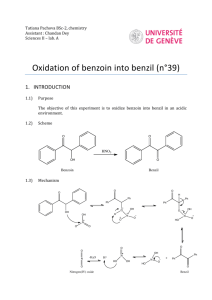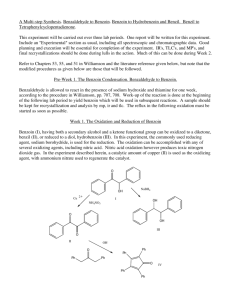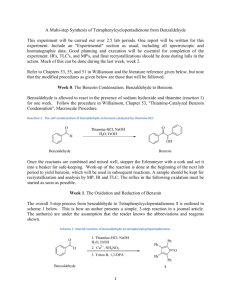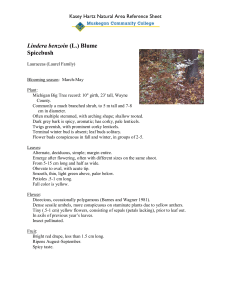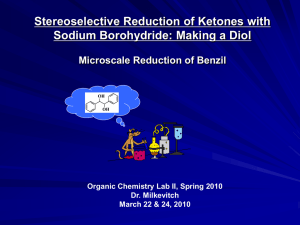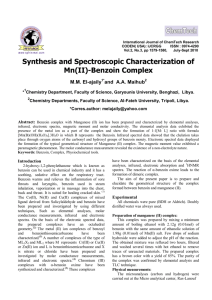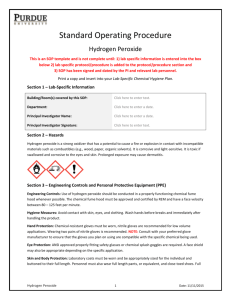290715221752AbstractofPaperforSusChemE2015byA.S.Kamble
advertisement
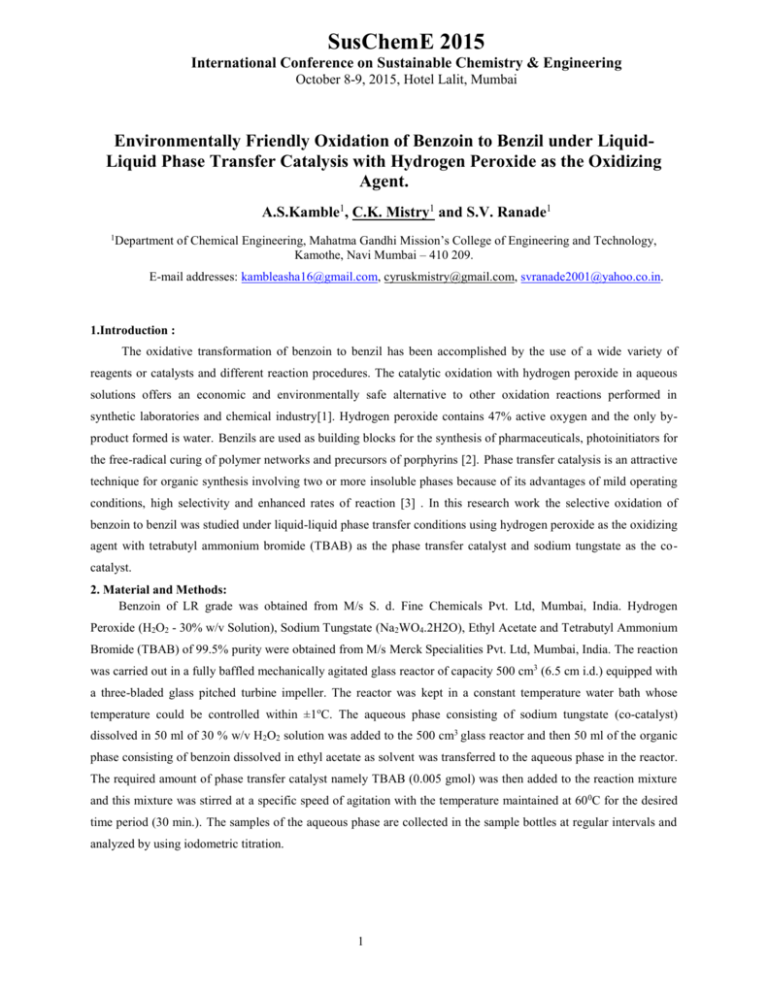
SusChemE 2015 International Conference on Sustainable Chemistry & Engineering October 8-9, 2015, Hotel Lalit, Mumbai Environmentally Friendly Oxidation of Benzoin to Benzil under LiquidLiquid Phase Transfer Catalysis with Hydrogen Peroxide as the Oxidizing Agent. A.S.Kamble1, C.K. Mistry1 and S.V. Ranade1 1 Department of Chemical Engineering, Mahatma Gandhi Mission’s College of Engineering and Technology, Kamothe, Navi Mumbai – 410 209. E-mail addresses: kambleasha16@gmail.com, cyruskmistry@gmail.com, svranade2001@yahoo.co.in. 1.Introduction : The oxidative transformation of benzoin to benzil has been accomplished by the use of a wide variety of reagents or catalysts and different reaction procedures. The catalytic oxidation with hydrogen peroxide in aqueous solutions offers an economic and environmentally safe alternative to other oxidation reactions performed in synthetic laboratories and chemical industry[1]. Hydrogen peroxide contains 47% active oxygen and the only byproduct formed is water. Benzils are used as building blocks for the synthesis of pharmaceuticals, photoinitiators for the free-radical curing of polymer networks and precursors of porphyrins [2]. Phase transfer catalysis is an attractive technique for organic synthesis involving two or more insoluble phases because of its advantages of mild operating conditions, high selectivity and enhanced rates of reaction [3] . In this research work the selective oxidation of benzoin to benzil was studied under liquid-liquid phase transfer conditions using hydrogen peroxide as the oxidizing agent with tetrabutyl ammonium bromide (TBAB) as the phase transfer catalyst and sodium tungstate as the cocatalyst. 2. Material and Methods: Benzoin of LR grade was obtained from M/s S. d. Fine Chemicals Pvt. Ltd, Mumbai, India. Hydrogen Peroxide (H2O2 - 30% w/v Solution), Sodium Tungstate (Na2WO4.2H2O), Ethyl Acetate and Tetrabutyl Ammonium Bromide (TBAB) of 99.5% purity were obtained from M/s Merck Specialities Pvt. Ltd, Mumbai, India. The reaction was carried out in a fully baffled mechanically agitated glass reactor of capacity 500 cm3 (6.5 cm i.d.) equipped with a three-bladed glass pitched turbine impeller. The reactor was kept in a constant temperature water bath whose temperature could be controlled within ±1oC. The aqueous phase consisting of sodium tungstate (co-catalyst) dissolved in 50 ml of 30 % w/v H2O2 solution was added to the 500 cm3 glass reactor and then 50 ml of the organic phase consisting of benzoin dissolved in ethyl acetate as solvent was transferred to the aqueous phase in the reactor. The required amount of phase transfer catalyst namely TBAB (0.005 gmol) was then added to the reaction mixture and this mixture was stirred at a specific speed of agitation with the temperature maintained at 60 0C for the desired time period (30 min.). The samples of the aqueous phase are collected in the sample bottles at regular intervals and analyzed by using iodometric titration. 1 SusChemE 2015 International Conference on Sustainable Chemistry & Engineering October 8-9, 2015, Hotel Lalit, Mumbai 3. Results and Discussion : The conversion of benzoin was observed to increase with increase in reaction temperature up to 333K (600C). The reaction was found to be first order with respect to the concentration of benzoin. The initial rate of reaction was found to increase linearly with the concentration of hydrogen peroxide, the concentration of the phase transfer catalyst and the concentration of the co-catalyst. Conversion Vs Time Conversion(%) 100 303K 80 313K 60 40 323K 20 333K 0 0 20 40 Time(min) Figure 1: Effect of Temperature on Oxidation of Benzoin 4. References : [1] Parshall, G., Ittel, S., Eds., Homogeneous Catalysis, 2nd Ed., John Wiley & Sons, Inc., 1992. [2] McKillop, A.; Swann, B. P.; Ford, M. E.; Taylor, E. C. J. Am. Chem. Soc. 1973, 95, 3641–3645. [3] C.M. Starks, C.L. Liotta, M. Halpern, Phase Transfer Catalysis: Fundamentals, Application, and Industrial Perspectives, Chapman and Hall, New York, 1994. 2

